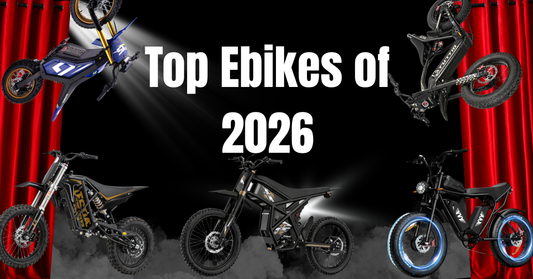Terrain Impact on E-Bike Riding Time: How Different Surfaces Affect Battery Usage
Picture this: You’re cruising on your shiny e-bike, feeling like the king of the road—until suddenly, you hit a patch of gravel and feel like you’re riding a bucking bronco. Your battery gauge starts mocking you like an old friend who knows your downhill speed is going to tank. Or maybe you’re puffing up a hill so steep it feels like Mount Everest got jealous and decided to move to your neighborhood. And then it starts raining—because, of course, it does. Welcome to the wild world where terrain impact on e-bike riding time is not just a fancy phrase, but a very real battery-draining drama.
If you’ve ever wondered why your e-bike’s “up to 50 miles on a charge” suddenly feels more like “hope you packed a sandwich,” stick around. This isn’t just about your battery—it’s about how rocks, hills, and raindrops turn your smooth ride into an epic adventure. Let’s dive into the gritty, gravelly, and downright slippery truth behind the terrain's impact on e-bike riding time.
Why Terrain Impact on E-Bike Riding Time Matters
When you buy an e-bike, manufacturers often advertise riding ranges under ideal conditions that rarely match real-world experiences. Terrain is one of the primary factors that contributes to this gap between expectation and reality.
- Flat, smooth surfaces offer the least resistance and energy consumption, thus maximizing your e-bike’s range.
- Rougher terrains, including gravel and uneven trails, increase rolling resistance and force your motor to work harder.
- Inclines require additional power, rapidly draining the battery compared to flat paths.
- Wet or slippery conditions often lead to more cautious riding with frequent acceleration and deceleration, impacting energy use.
By understanding the terrain's impact on e-bike riding time, riders can better prepare, plan routes strategically, and avoid unexpected power shortages.
Gravel Terrain: The Challenge of Loose Surfaces
Riding on gravel or loose dirt trails is a favorite activity for many adventure riders, but it comes with its own set of challenges. Gravel surfaces typically increase rolling resistance, which means your e-bike motor needs to apply more power to maintain speeds.
- Increased battery drain: Loose surfaces make your tires sink slightly, requiring more energy.
- Speed adjustments: Riders often slow down or speed up frequently for balance, which consumes extra battery power.
- Tire tread and suspension: Wider tires and suspension systems help absorb bumps, but they can affect energy use.
To maximize battery life on gravel, consider lowering your pedal-assist level and maintaining a steady cadence rather than frequent stops and starts.
Hills and Inclines: The Battery’s Uphill Struggle
Climbing hills is the most energy-intensive activity for any e-bike motor. Steeper and longer inclines increase the load on the battery dramatically.
- Higher motor output: The motor consumes more current to assist pedal power on slopes.
- Reduced range: Expect your battery to drain 20-30% faster or more on hilly routes.
- Regenerative braking: Some e-bikes feature regenerative braking that recovers energy on descents, but it usually isn’t enough to offset the uphill consumption.
Planning routes that avoid unnecessary large climbs or breaking long climbs into smaller segments can help manage battery use. Also, opting for e-bikes with mid-drive motors usually improves climbing efficiency.
Wet Roads and Rainy Conditions: The Hidden Battery Costs
Wet or slippery surfaces might not seem taxing, but riding in rain or wet roads impacts your e-bike’s efficiency through:
- Cautious riding: Due to lower traction, riders tend to accelerate and brake more often, increasing battery consumption.
- Increased resistance: Water on roads can slightly increase rolling resistance, especially on unsealed surfaces.
- Battery and motor protection: Some e-bikes reduce motor power output in wet conditions as a safety precaution, which can affect riding performance.
For wet-weather rides, regularly checking tire pressure and choosing tires with good wet grip can help maintain efficiency and safety.
Tips to Maximize Riding Time Despite Terrain Impact on E-Bike Riding Time
Understanding terrain impact is the first step. Here are actionable ways to conserve battery and get the most out of your rides:
- Use lower pedal-assist levels on difficult terrain: Higher assist means faster battery depletion.
- Maintain consistent pedaling cadence: Avoid frequent stops and sprints to reduce energy spikes.
- Keep tires inflated to correct pressure: Properly inflated tires reduce rolling resistance.
- Select the right tires: Wider tires with appropriate tread improve control but may slightly reduce range; find your balance.
- Plan your route with terrain in mind: Use apps like Ride with GPS or Komoot to chart less strenuous paths.
- Carry a portable charger: For extended rides in unpredictable terrain, a charger is a must.
- Choose an e-bike with regenerative braking if you frequently ride hilly terrain.
Final Thoughts on Terrain Impact on E-Bike Riding Time and Battery Efficiency
No two rides are the same, and terrain will always play a pivotal role in your e-bike’s riding time and battery usage. Being aware of the conditions and adapting your riding style accordingly can significantly extend your range. Whether cruising urban roads, tackling gravel paths, or climbing hills, the knowledge of terrain impact on e-bike riding time lets you ride with confidence, knowing how to conserve power and plan smart.


